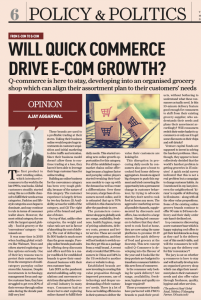It’s been more than 15 years since the start of modern retail in India and by now, it should have attained maturity.
Unfortunately, it’s nowhere close to the global standards. This could be because of lack of skills or expertise, but it could also be because the Indian market is so big that major players have not really paid much attention to establishing systems and practices. Instead, they focussed on capturing space.

Retail in India today is more of a sophisticated distribution business than one that delivers a shopping experience.
Consumers are still not getting what they deserve in terms of service, value for money and choice.
This is mainly because what we see in stores is driven by supply and not demand. Retailers source products, and then line shelves, rather than first finding out what people want and providing it.
Modern retailers need to realise that for regular purchases, consumers have affiliations towards a certain store or chain of stores because they know they get their products there all the time, at the right price. We have preferences towards certain brands, products and even pack sizes.
The tea I buy is a 250 gm Red Label Tea, but when I walk into a supermarket I’m never sure whether I’ll get it.
I might be forced to buy a 500 gm pack or a Red Label Plus or Natural. It is more or less the same in every brand of supermarket I go to.
It’s the same with lifestyle and fashion. People shop at the same store regularly because they expect to find the style they’re looking for. In case my office wardrobe consists of stripes and gentle colours, I must be able find this range at a store of my choice.
Instead, I may have to spend several hours browsing through different shops before I find something I would wear to work. Unfortunately, today in our country, we have shops that look like international retail stores, but they provide a very different shopping experience.
And that’s where FDI comes in. Forget the politics and economics behind it. What FDI will do is bring in global practices and processes that’s missing from Indian retail. A Tesco customer will be treated the same — in England or in India.
The major change that will bring to our retail is what the consumer will experience and then expect.
One of these will be the utilisation of loyalty programmes. Most global retailers separate their customers into two groups — known and unknown consumers. Known consumers are tracked through loyalty cards and unknown ones through other means like credit card numbers. Retailers analyse shopping habits and can even predict what will be in loyal consumers’ baskets in their next shopping cycle.
Then, they make sure the store stocks those consumer’s needs each time they return. In parts of London with a high density Gujarati population, Tesco even stocks canned Undhiyu.
They also create products based on customer behaviour. Sainsbury’s is known for its range of health and beauty products. Tesco stocks more than 50 different kinds of tomato ketchups.
Their range of tomato ketch-up has now become a market driver. Because of that, they sell more chips and more beer and any other product that the customer wants.
That’s what a private label can do — bring high value and low-cost products to consumers. It doesn’t really happen in India today, but when large retailers enter our market, their value systems will become part of modern Indian retail.
We can’t really predict whether traders will lose business because of FDI or how big the benefits will be to farmers. What is absolutely sure is that modern Indian consumers will gain in terms of value, price benefit and finally get the shopping experience they deserve.
From a series of articles commissioned by DNA (Money) dated 7 December 2011.



